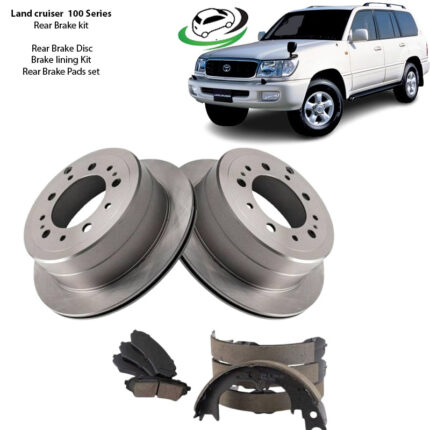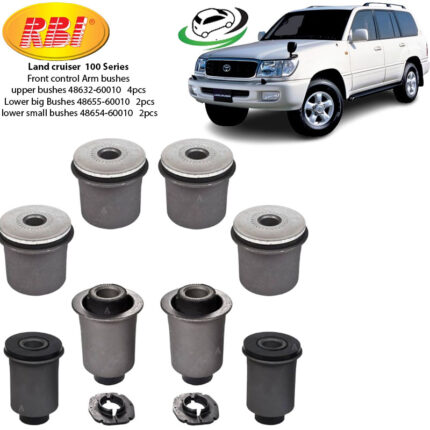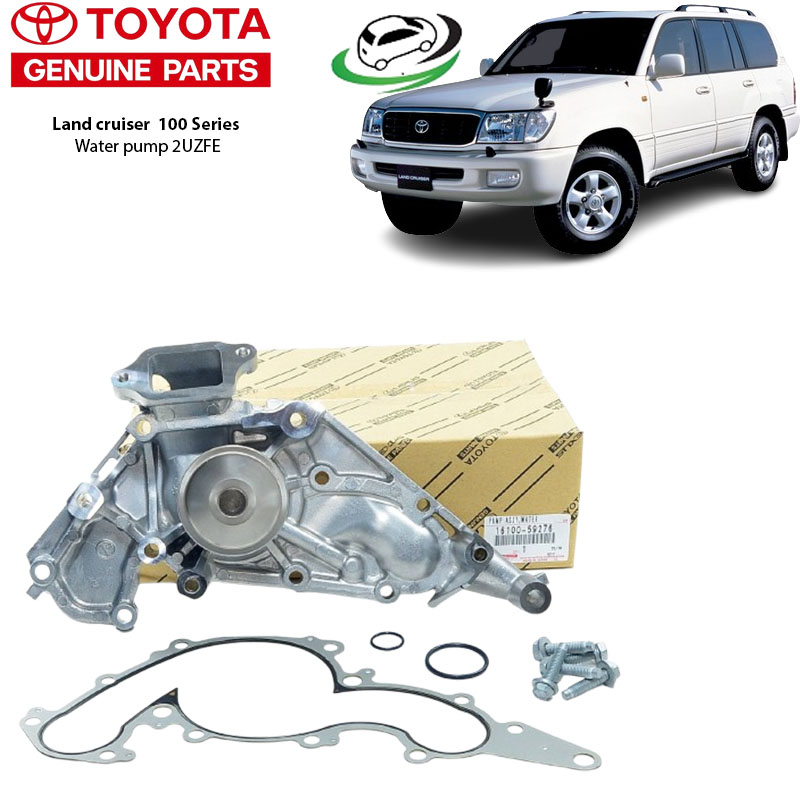-7%
Get Toyota Landcruiser 100 Series Water Pump 2UZFE 16100-59274
The water pump in the Toyota Landcruiser 100 Series plays a critical role in the vehicle’s cooling system. It ensures the engine operates within optimal temperature ranges by circulating coolant through the engine and radiator. Given the Landcruiser’s rugged reputation and demanding operational conditions—whether towing heavy loads, off-roading, or driving long distances—maintaining the water pump is crucial for preventing overheating and ensuring long-term engine health.
This guide provides an in-depth look at the Toyota Landcruiser 100 Series water pump, covering its function, benefits, signs of wear, replacement tips, and maintenance guidelines.
What is a Water Pump?
The water pump is a mechanical device designed to move coolant through the vehicle’s engine and cooling system. In the Toyota Landcruiser 100 Series, the water pump is typically driven by the engine’s serpentine belt or timing belt. The coolant absorbs heat from the engine, and the water pump circulates it to the radiator, where it dissipates the heat before being recirculated back into the engine.
Components of a Water Pump
A typical water pump consists of:
- Housing: Usually made from aluminum or cast iron, this casing houses the pump’s components.
- Impeller: A rotating component, the impeller moves the coolant through the cooling system.
- Pulley: Attached to the impeller, the pulley connects to the engine belt system and drives the impeller.
- Shaft: The shaft connects the pulley and impeller, transferring engine power to the pump.
- Bearings: Bearings ensure smooth rotation of the shaft and impeller.
- Seals: These prevent coolant from leaking out of the pump.
Function of the Water Pump
The water pump’s primary function is to regulate engine temperature by circulating coolant. As the engine operates, it generates heat. Without proper cooling, this heat could cause engine components to expand or warp, leading to costly damage. The water pump helps prevent overheating by:
- Maintaining Coolant Flow: It ensures a constant flow of coolant through the engine block, cylinder heads, and radiator.
- Cooling Hot Coolant: By pushing hot coolant to the radiator, where it cools down, the water pump allows the engine to maintain optimal operating temperatures.
- Consistent Performance: The pump operates continuously as the engine runs, ensuring that heat is efficiently removed throughout your driving experience.
Benefits of a High-Quality Water Pump
Using a high-quality water pump for your Toyota Landcruiser 100 Series offers several advantages. Given that the water pump is central to engine cooling, these benefits not only improve performance but also extend the life of the engine.
1. Prevents Overheating
Overheating is one of the leading causes of engine damage. A high-quality water pump ensures that coolant is constantly circulating through the system, preventing excessive heat buildup. This is particularly important for vehicles like the Landcruiser, which may encounter extreme operating conditions during off-road driving or towing.
2. Prolongs Engine Lifespan
Proper cooling reduces wear and tear on the engine components. When the engine is kept at optimal temperature, it operates more efficiently and experiences less thermal stress. This can significantly prolong the lifespan of internal components like the cylinder head, pistons, and gaskets.
3. Reduces Maintenance Costs
A reliable water pump minimizes the risk of overheating, which can lead to catastrophic engine failure. By preventing such damage, a high-quality pump helps reduce the need for expensive engine repairs or replacements.
4. Increases Fuel Efficiency
Engines operate most efficiently within a specific temperature range. When the engine stays cool, combustion processes are more controlled, leading to better fuel economy. An efficient water pump ensures that the engine stays within this range, helping you save on fuel costs.
5. Smooth Operation
A well-functioning water pump ensures smooth operation of the cooling system. By circulating coolant effectively, it reduces the chances of temperature fluctuations, which can cause inconsistent engine performance and discomfort during driving.
Signs of a Failing Water Pump
The water pump is a robust component, but like all parts, it can wear out over time. A failing water pump can lead to serious engine issues if not addressed promptly. Here are the most common signs of water pump failure in a Toyota Landcruiser 100 Series:
1. Coolant Leaks
One of the earliest signs of a failing water pump is a coolant leak. Water pumps use seals to prevent coolant from escaping. Over time, these seals can wear out, leading to coolant leakage around the water pump. If you notice a puddle of coolant (typically a bright green, yellow, or pink fluid) under the vehicle, it’s likely that the water pump is leaking.
2. Overheating Engine
If the water pump fails, it won’t be able to circulate coolant properly, leading to engine overheating. If the temperature gauge shows that the engine is running hot, it could be a sign of water pump failure. It’s essential to address this issue immediately, as prolonged overheating can cause engine damage.
3. Grinding or Whining Noises
The bearings inside the water pump allow for smooth rotation of the impeller. If these bearings wear out, they can produce grinding or whining noises while the engine is running. This noise indicates that the water pump is failing and needs to be replaced.
4. Steam from the Radiator
If you notice steam coming from the front of the vehicle, particularly near the radiator, it could indicate that the water pump is not functioning properly. The steam is a result of the coolant overheating and boiling over, which is a clear sign of insufficient cooling.
5. Corrosion or Rust
Corrosion or rust on the water pump’s exterior is often a result of coolant leakage. Over time, coolant that seeps from the water pump can lead to rust or mineral buildup. This is another indication that the water pump may be failing and requires attention.
Water Pump Maintenance and Replacement Tips
Regular maintenance and timely replacement of the water pump are essential to ensure the longevity of the Toyota Landcruiser 100 Series engine. Here are some practical tips for water pump care and replacement:
1. Check Coolant Levels Regularly
One of the easiest ways to monitor the health of the water pump is by regularly checking coolant levels. Low coolant levels could indicate a leak, which may be coming from the water pump. Always ensure that coolant levels are topped up to the manufacturer-recommended levels.
2. Inspect for Leaks
Regularly inspect the area around the water pump for any signs of coolant leakage. Early detection of a leak can prevent more significant damage and reduce the risk of engine overheating.
3. Replace the Water Pump with Timing Belt
In many cases, the water pump is driven by the timing belt. If your Landcruiser 100 Series is due for a timing belt replacement, it’s recommended to replace the water pump at the same time. This can save on labor costs and reduce the risk of a pump failure shortly after timing belt replacement.
4. Use Genuine or High-Quality Replacement Parts
When replacing the water pump, always opt for genuine Toyota parts or high-quality aftermarket alternatives. Inferior parts may not offer the same level of performance and could fail prematurely.
5. Monitor Engine Temperature
Pay attention to the vehicle’s temperature gauge while driving. Any sudden spikes in temperature should be addressed immediately. If you suspect the water pump is failing, it’s best to avoid driving the vehicle until it can be inspected by a professional.
6. Seek Professional Assistance
Replacing a water pump can be a complex task, especially if it involves removing the timing belt. It’s best to have the replacement carried out by a professional mechanic who is familiar with the Toyota Landcruiser 100 Series.
Conclusion
The water pump in the Toyota Landcruiser 100 Series is a vital component of the cooling system, ensuring that the engine operates within safe temperature limits. By maintaining the water pump and addressing signs of wear or failure early on, you can protect the engine from overheating and prolong its lifespan. Regular inspections, timely replacements, and using high-quality parts are essential for keeping your Landcruiser in peak condition, whether you’re exploring rugged terrains or cruising on highways.
Follow us on Facebook for more parts.




Reviews
Clear filtersThere are no reviews yet.